Daily News
by Gail Helmer
[ Send Us News | Archives ]
New Screens: LO:MAC
Ubi Soft has released two new screenshots from Lock On: Modern Air Combat.
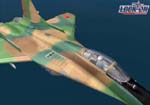
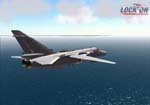
Free Play Extended for WWII Online
Playnet and Strategy First announced that they are extending the free play time for WWII Online through January 31st, 2002 for all former account holders. After having just released version 1.5.2, Playnet wants to give players more time to experience the new features and improvements in the game. Players are invited to come back and try World War II Online for free and if they've already come back, to enjoy the added free play time. WWII Online
Red Shark Trailer Released
Russian developers G5 Software has released a 2 minute videoclip of their upcoming arcade helicopter shooter "Red Shark". Red shark is set in 2010 players complete 15, thoroughly planned by Russian special forces, missions of point correction of the past. Release Date: March 2002 Red Shark
AMD Unveils New Laptop Processor
AMD today introduced the mobile AMD Athlon(tm) 4 processor 1500+, the highest overall performing processor for notebook PCs. The new mobile processor, featuring QuantiSpeed(tm) architecture and AMD PowerNow!(tm) technology. Systems based on the mobile AMD Athlon 4 processor 1500+ are expected to be immediately available from Compaq Computer Corporation. Joining the AMD Athlon XP and AMD Athlon MP processors, the new mobile processor will be identified with model numbers, as opposed to clock speed in megahertz. In October 2001, AMD announced the True Performance Initiative (TPI), through which AMD will assist customers in understanding the benefits of PC performance. The TPI also will help define a more accurate measure of processor performance for standard applications.
New Email Worm 'My Party' Surfaces
LONDON (Reuters) - A new computer bug that tries to trick computer users into clicking on a virus-infected Web link masquerading as party photos emerged in Asia on Monday morning and began spreading to Europe, computer experts said. The so-called "My Party" worm, which is not considered destructive, spreads by infiltrating popular email software Microsoft Windows Address Book and Outlook Express Database. The worm emails itself to every person in an infected users' email log making it look as if the worm comes from a colleague or friend, experts said. [More...]
Military News
Missile-3 Destroys a Ballistic Missile Target
A Raytheon Company STANDARD Missile-3 (SM-3) intercepted a ballistic missile target in space during a Jan. 25 Missile Defense Agency Sea-based Missile Defense System (SMD) flight test off the Hawaii coast. The success of this test, sponsored by the Missile Defense Agency, moves the U.S. Navy a step closer to fielding a sea-based missile defense capability.
By intercepting the target and exceeding mission objectives, the SM-3 and supporting systems demonstrated the capability to provide the country with Sea-based Missile Defense.

The test, designated Flight Mission-2 (FM-2), was designed to evaluate the fourth-stage kinetic warhead interceptor's guidance, navigation and control capabilities. It was the Sea-based Missile Defense (SMD) program's third successful flight and first target intercept. It was also the first using an operational Solid Divert and Attitude Control System (SDACS). The missile, kinetic interceptor and the rest of the system performed just as expected.
In the test, an Aries target was launched from Kauai to verify the SM-3 interceptor's characterization functions. USS LAKE ERIE (CG 70) tracked the missile as it rose above the horizon, and then launched the SM-3. The missile, with guidance commands from the AEGIS Weapon System, flew a nominal trajectory and delivered the SM-3 interceptor into space at which point it was ejected as planned.
The interceptor acquired and tracked the target in the exoatmosphere above the mid-Pacific Ocean. As the interceptor approached the Aries, it used its divert thrusters to maneuver into the path of the target missile. This mission was the first operational SM-3 kinetic warhead with a live SDACS. The SM-3 provides a burnout velocity of approximately three kilometers per second, with closing velocities between the target and missile approaching four kilometers a second.
The launch was the fourth in a planned series of nine test flights for SMD, formerly called the Navy Theater Wide ballistic missile defense system. SM-3 is designed to intercept an incoming theater ballistic missile outside the earth's atmosphere. The kinetic warhead is based on technology developed during the Lightweight Exo-Atmospheric Projectile (LEAP) program. SM-3 and the kinetic warhead are under development by Raytheon Electronic Systems at its Missile Systems business unit in Tucson, Ariz., with major subsystems developed by Alliant Techsystems and the Boeing Company.
Unmanned Aerial Vehicle Crashes On Landing
An Air Force RQ-1 Predator unmanned aerial vehicle supporting Operation Enduring Freedom crash-landed Jan. 25 while returning to its base in the Central Command theater of operations. The crash was not the result of hostile fire, and the aircraft was completely destroyed, officials said.
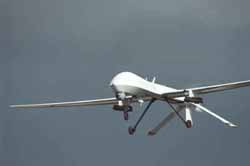
The RQ-1 Predator is an unmanned reconnaissance and surveillance system designed to provide military commanders high-resolution, real-time imagery of large population areas. The cause of the crash is under investigation.
Global Hawk Development On Track At Edwards
With a deployment debut behind them, Global Hawk test experts at the Air Force Flight Test Center here are pushing forward with development of the high-altitude unmanned aerial vehicle. Global Hawk is now in the engineering, manufacturing and development phase of defense acquisition, which began last March.
The UAV is designed to provide battlefield commanders with near real-time, high-resolution, reconnaissance imagery. Flying at extremely high altitudes, Global Hawk can survey large geographic areas, giving military decision-makers the most current information about enemy resources and personnel.
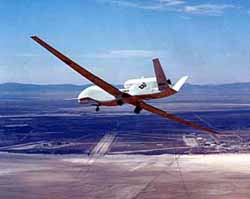
The 452nd Flight Test Squadron, part of the Global Vigilance Combined Test Force here, is working to incorporate many of the lessons learned from the system’s recent deployment in support of Operation Enduring Freedom into the developmental test process.
The deployment was unique in that Global Hawk was used in theater by nontraditional crewmembers mostly from the test and evaluation community. Operational and developmental military testers supported by contractor maintenance and support crews provided combatants the new reconnaissance capabilities throughout the Global Hawk deployment.
The experience is allowing the Global Hawk team to develop a production representative vehicle that is exactly what the warrior needs, said Lt. Col. Michael Guidry, commander of the 452nd FTS and director of the Global Vigilance CTF. Such a vehicle is the final version of a weapon system before it heads to low-rate initial production.
"As part of (engineering, manufacturing and development) we would have conducted certain tests, but because of recent events we were able to accomplish these evaluations through actual operational flights," said Guidry, who deployed with the Global Hawk during its combat debut. "This will significantly benefit the test program in that it minimizes the required sorties necessary to complete the test process and allows us to make the most out of those sorties we do fly."
The Global Hawk team is looking into methods that will provide better data-link connectivity between the UAV and its ground-based operators, Guidry said.
Part of the solution is to simplify and miniaturize the units that house ground operations, he said. The team is also focused on improving data-collection techniques and response times by bringing more automation to the image-collection process.
"We are there to collect imagery, but it isn’t beneficial if we can’t deliver that picture or image to the warfighter," Guidry said.
To ensure a successful EMD phase, the test force here is continuing to work closely with the reconnaissance systems program office at the Aeronautical Systems Center, Wright-Patterson Air Force Base, Ohio. The office assumed program control in 1998 and is responsible for moving Global Hawk toward low-rate initial production.
The operational experience the entire Global Hawk team has had can only benefit the future program, said Col. Wayne Johnson, director of Global Hawk at the System Program Office.
From the requirements and development stages through the transition to operations and sustainment, the early deployment will help the team mature Global Hawk into one of the finest intelligence, surveillance and reconnaissance assets in the world, Johnson said.
"Integral to this maturity is the test experts at Edwards and the insight they provide into how well the design meets the requirement," Johnson said. "Their developmental and early operational tests are extremely important in fielding a tremendous and much needed asset to the warfighter."
Besides enhancing connectivity and data-collection, Guidry said the test force here is also further developing the EMD test plan and making improvements to Global Hawk’s overall mission-planning process.
These preparations will assist with a smooth integration of another test bird expected to arrive here this summer, he said.
The next vehicle following the summer arrival should be production representative, Guidry said.
USS Greeneville Strikes Again
Two U.S. Navy 5th Fleet ships participating in Operation Enduring Freedom collided Jan. 27 about 40 nautical miles off the coast of Oman, Clarke said. The USS Greeneville, an attack submarine, collided with the USS Ogden, an amphibious transport ship, Jan. 27. She said both ships were on the surface transferring personnel from the Greeneville to the Ogden when the accident occurred, she said.
Preliminary reports indicate that the hull of the Ogden and the Greeneville stern plate came into contact, which resulted in a rupture to one of the Ogden's fuel tanks, Clarke said. The 5-by-18-inch long rupture is below the waterline at the back on the right side, a Navy official explained.
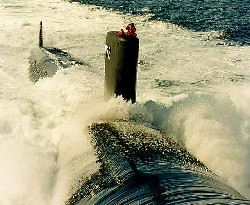
Both ships continue to operate safely. "The Greeneville is fully operational and is headed toward Diego Garcia so there can be an underwater assessment," she said. The collision is under investigation.
The Greeneville also collided with the Japanese fishing boat Ehime Maru off Hawaii while surfacing last February. Nine Japanese on the fishing boat died when the vessel sank. In the summer, the Greeneville scraped the bottom of the harbor in Saipan, a Pacific island in the U.S. commonwealth of the Northern Mariana Islands, while trying to maneuver.
[ Send Us News | Archives ]
by Gail Helmer
Monday January 28, 2002
- New Screens: LO:MAC
- Free Play Extended for WWII Online
- Red Shark Trailer Released
- AMD Unveils New Laptop Processor
- New Email Worm 'My Party' Surfaces
- Missile-3 Destroys a Ballistic Missile Target
- Unmanned Aerial Vehicle Crashes On Landing
- Global Hawk Development On Track At Edwards
- USS Greeneville Strikes Again
New Screens: LO:MAC
Ubi Soft has released two new screenshots from Lock On: Modern Air Combat.


Free Play Extended for WWII Online
Playnet and Strategy First announced that they are extending the free play time for WWII Online through January 31st, 2002 for all former account holders. After having just released version 1.5.2, Playnet wants to give players more time to experience the new features and improvements in the game. Players are invited to come back and try World War II Online for free and if they've already come back, to enjoy the added free play time. WWII Online
Red Shark Trailer Released
Russian developers G5 Software has released a 2 minute videoclip of their upcoming arcade helicopter shooter "Red Shark". Red shark is set in 2010 players complete 15, thoroughly planned by Russian special forces, missions of point correction of the past. Release Date: March 2002 Red Shark
AMD Unveils New Laptop Processor
AMD today introduced the mobile AMD Athlon(tm) 4 processor 1500+, the highest overall performing processor for notebook PCs. The new mobile processor, featuring QuantiSpeed(tm) architecture and AMD PowerNow!(tm) technology. Systems based on the mobile AMD Athlon 4 processor 1500+ are expected to be immediately available from Compaq Computer Corporation. Joining the AMD Athlon XP and AMD Athlon MP processors, the new mobile processor will be identified with model numbers, as opposed to clock speed in megahertz. In October 2001, AMD announced the True Performance Initiative (TPI), through which AMD will assist customers in understanding the benefits of PC performance. The TPI also will help define a more accurate measure of processor performance for standard applications.
New Email Worm 'My Party' Surfaces
LONDON (Reuters) - A new computer bug that tries to trick computer users into clicking on a virus-infected Web link masquerading as party photos emerged in Asia on Monday morning and began spreading to Europe, computer experts said. The so-called "My Party" worm, which is not considered destructive, spreads by infiltrating popular email software Microsoft Windows Address Book and Outlook Express Database. The worm emails itself to every person in an infected users' email log making it look as if the worm comes from a colleague or friend, experts said. [More...]
Military News
Missile-3 Destroys a Ballistic Missile Target
A Raytheon Company STANDARD Missile-3 (SM-3) intercepted a ballistic missile target in space during a Jan. 25 Missile Defense Agency Sea-based Missile Defense System (SMD) flight test off the Hawaii coast. The success of this test, sponsored by the Missile Defense Agency, moves the U.S. Navy a step closer to fielding a sea-based missile defense capability.
By intercepting the target and exceeding mission objectives, the SM-3 and supporting systems demonstrated the capability to provide the country with Sea-based Missile Defense.

The test, designated Flight Mission-2 (FM-2), was designed to evaluate the fourth-stage kinetic warhead interceptor's guidance, navigation and control capabilities. It was the Sea-based Missile Defense (SMD) program's third successful flight and first target intercept. It was also the first using an operational Solid Divert and Attitude Control System (SDACS). The missile, kinetic interceptor and the rest of the system performed just as expected.
In the test, an Aries target was launched from Kauai to verify the SM-3 interceptor's characterization functions. USS LAKE ERIE (CG 70) tracked the missile as it rose above the horizon, and then launched the SM-3. The missile, with guidance commands from the AEGIS Weapon System, flew a nominal trajectory and delivered the SM-3 interceptor into space at which point it was ejected as planned.
The interceptor acquired and tracked the target in the exoatmosphere above the mid-Pacific Ocean. As the interceptor approached the Aries, it used its divert thrusters to maneuver into the path of the target missile. This mission was the first operational SM-3 kinetic warhead with a live SDACS. The SM-3 provides a burnout velocity of approximately three kilometers per second, with closing velocities between the target and missile approaching four kilometers a second.
The launch was the fourth in a planned series of nine test flights for SMD, formerly called the Navy Theater Wide ballistic missile defense system. SM-3 is designed to intercept an incoming theater ballistic missile outside the earth's atmosphere. The kinetic warhead is based on technology developed during the Lightweight Exo-Atmospheric Projectile (LEAP) program. SM-3 and the kinetic warhead are under development by Raytheon Electronic Systems at its Missile Systems business unit in Tucson, Ariz., with major subsystems developed by Alliant Techsystems and the Boeing Company.
Unmanned Aerial Vehicle Crashes On Landing
An Air Force RQ-1 Predator unmanned aerial vehicle supporting Operation Enduring Freedom crash-landed Jan. 25 while returning to its base in the Central Command theater of operations. The crash was not the result of hostile fire, and the aircraft was completely destroyed, officials said.

The RQ-1 Predator is an unmanned reconnaissance and surveillance system designed to provide military commanders high-resolution, real-time imagery of large population areas. The cause of the crash is under investigation.
Global Hawk Development On Track At Edwards
With a deployment debut behind them, Global Hawk test experts at the Air Force Flight Test Center here are pushing forward with development of the high-altitude unmanned aerial vehicle. Global Hawk is now in the engineering, manufacturing and development phase of defense acquisition, which began last March.
The UAV is designed to provide battlefield commanders with near real-time, high-resolution, reconnaissance imagery. Flying at extremely high altitudes, Global Hawk can survey large geographic areas, giving military decision-makers the most current information about enemy resources and personnel.

The 452nd Flight Test Squadron, part of the Global Vigilance Combined Test Force here, is working to incorporate many of the lessons learned from the system’s recent deployment in support of Operation Enduring Freedom into the developmental test process.
The deployment was unique in that Global Hawk was used in theater by nontraditional crewmembers mostly from the test and evaluation community. Operational and developmental military testers supported by contractor maintenance and support crews provided combatants the new reconnaissance capabilities throughout the Global Hawk deployment.
The experience is allowing the Global Hawk team to develop a production representative vehicle that is exactly what the warrior needs, said Lt. Col. Michael Guidry, commander of the 452nd FTS and director of the Global Vigilance CTF. Such a vehicle is the final version of a weapon system before it heads to low-rate initial production.
"As part of (engineering, manufacturing and development) we would have conducted certain tests, but because of recent events we were able to accomplish these evaluations through actual operational flights," said Guidry, who deployed with the Global Hawk during its combat debut. "This will significantly benefit the test program in that it minimizes the required sorties necessary to complete the test process and allows us to make the most out of those sorties we do fly."
The Global Hawk team is looking into methods that will provide better data-link connectivity between the UAV and its ground-based operators, Guidry said.
Part of the solution is to simplify and miniaturize the units that house ground operations, he said. The team is also focused on improving data-collection techniques and response times by bringing more automation to the image-collection process.
"We are there to collect imagery, but it isn’t beneficial if we can’t deliver that picture or image to the warfighter," Guidry said.
To ensure a successful EMD phase, the test force here is continuing to work closely with the reconnaissance systems program office at the Aeronautical Systems Center, Wright-Patterson Air Force Base, Ohio. The office assumed program control in 1998 and is responsible for moving Global Hawk toward low-rate initial production.
The operational experience the entire Global Hawk team has had can only benefit the future program, said Col. Wayne Johnson, director of Global Hawk at the System Program Office.
From the requirements and development stages through the transition to operations and sustainment, the early deployment will help the team mature Global Hawk into one of the finest intelligence, surveillance and reconnaissance assets in the world, Johnson said.
"Integral to this maturity is the test experts at Edwards and the insight they provide into how well the design meets the requirement," Johnson said. "Their developmental and early operational tests are extremely important in fielding a tremendous and much needed asset to the warfighter."
Besides enhancing connectivity and data-collection, Guidry said the test force here is also further developing the EMD test plan and making improvements to Global Hawk’s overall mission-planning process.
These preparations will assist with a smooth integration of another test bird expected to arrive here this summer, he said.
The next vehicle following the summer arrival should be production representative, Guidry said.
USS Greeneville Strikes Again
Two U.S. Navy 5th Fleet ships participating in Operation Enduring Freedom collided Jan. 27 about 40 nautical miles off the coast of Oman, Clarke said. The USS Greeneville, an attack submarine, collided with the USS Ogden, an amphibious transport ship, Jan. 27. She said both ships were on the surface transferring personnel from the Greeneville to the Ogden when the accident occurred, she said.
Preliminary reports indicate that the hull of the Ogden and the Greeneville stern plate came into contact, which resulted in a rupture to one of the Ogden's fuel tanks, Clarke said. The 5-by-18-inch long rupture is below the waterline at the back on the right side, a Navy official explained.

Both ships continue to operate safely. "The Greeneville is fully operational and is headed toward Diego Garcia so there can be an underwater assessment," she said. The collision is under investigation.
The Greeneville also collided with the Japanese fishing boat Ehime Maru off Hawaii while surfacing last February. Nine Japanese on the fishing boat died when the vessel sank. In the summer, the Greeneville scraped the bottom of the harbor in Saipan, a Pacific island in the U.S. commonwealth of the Northern Mariana Islands, while trying to maneuver.
